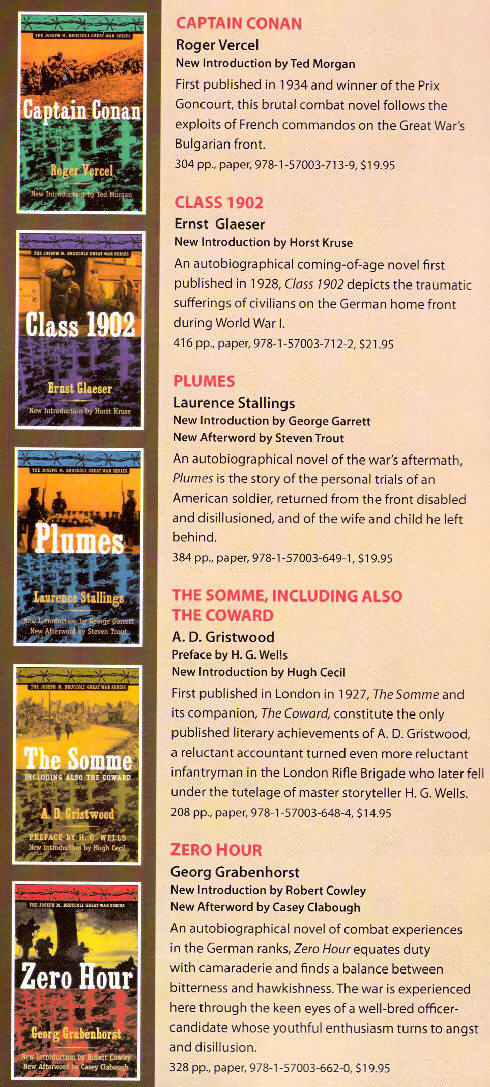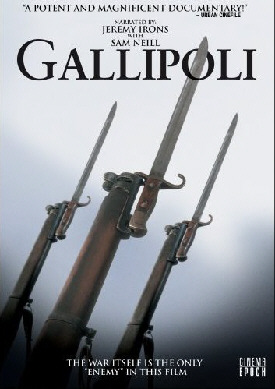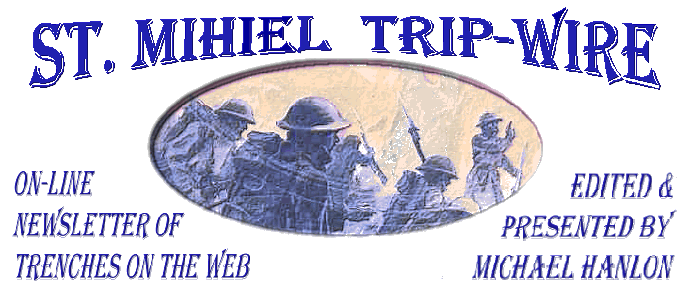
TRENCH REPORT: Last Friday, Valor Tours, operator of the annual World War I battlefield tours I lead, decided to add a second Western Front trip to their 2008 program. They had asked me to design an intensive seven-day, six-night program built around the huge Battle of the Marne reenactment planned for September 7th at Villeroy. It is titled Experiencing the Great War of 1914-1918 and is scheduled for September 6-12, 2008. Three of the greatest battles of the First World War will be closely studied from the point of view of a principal combatant: the First Battle of the Marne (1914, French), the Battle of the Somme (1916, British), and the Second Battle of the Marne (1918, U.S.) The itinerary also includes an optional visit to the Paris Air Museum. It is being priced out, and a brochure is being prepared now. Email me if you would like to receive one, (brochure). By the way, although the response has been terrific, it is not too late to sign up for our May 20-31 comprehensive Western Front Tour either. MH
This Month's Internet Feature
Notable Musical Composers at War
George Butterworth, Brit. Army, KIA Pozieres July 1916
Hanns Eisler, Austro-Hungarian Army, Wounded
Maurice Ravel, French, Transportation Corps
Ralph Vaughn Williams, Brit. Medical & Garrison Artillery
Irving Berlin, U.S., Yip, Yip, Yaphank
Four British Composers & Their Great War Music

French Grave Detail
New at Our Own & Our Friends' Great War Websites
Click on Title or Icon to Access
|
At Great War Society Sites
At the WFA-USA
|

Question: How were German forces able to penetrate the Allied lines so deeply in early 1918?
The German infiltration tactics of 1918 can be summarized under four headings: innovative artillery preparation; the combined arms assault or storm battalion; rejection of the linear advance in favor of bypassing enemy centers of resistance; and attacks to disorganize the enemy rear area.
The key was artillery. Col. Georg Bruckmüller, an obscure officer retired for nervous problems in 1913 but recalled to duty for the war, developed German artillery techniques to a fine art by the time of the Ludendorff Spring Offensives of 1918. The essence of the Bruckmüller artillery preparation was a carefully orchestrated, short but intense bombardment designed to isolate, demoralize and disorganize enemy defenders. Georg Bruckmüller avoided area targets, concentrating on such key points as artillery observation posts, command posts, radio and telephone centers, rearward troop concentrations, bridges, and major approach routes. He carefully pinpointed all these targets on aerial photographs. The result was to knock out enemy communications and isolate forward units.
The effect was increased by surprise. At the start of the German offensive on 21 March 1918, Bruckmüller began his bombardment with ten minutes of gas shells to force the British to mask, followed by four hours and twenty-five minutes of mixed gas and high explosives. The preparatory fires shifted back and forth, so that the British did not know when the artillery was actually lifting for the infantry advance. Meanwhile, automatic rifle teams moved as close as possible to the British positions during the bombardment. When the Germans did advance, they moved behind a rolling barrage, further enhanced by intense fog. The combination of surprise, brevity, intensity, and carefully selected targets was unique.Captain Jonathan M. House, U.S. Army, 1984
| Reader PO2 Clement Roy of the Canadian Forces first stumped us with a query and then forwarded the correct information. He was interested in the identity of the first Canadian soldier to be killed in the Great War. The answer is: Lance Corporal HENRY GEORGE BELLINGER of the Princess Patricia's Canadian Light Infantry, who died on January 8, 1915. He is buried at Voormezeele Enclosure No. 3 South of Ypres.
|
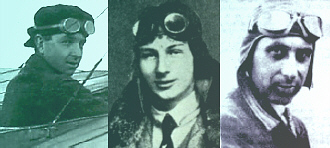
Posing With Goggles
Apparently De Rigueur for Aviation Pioneers
Thomas Sopwith, Anthony Fokker, Alexander de Seversky
|
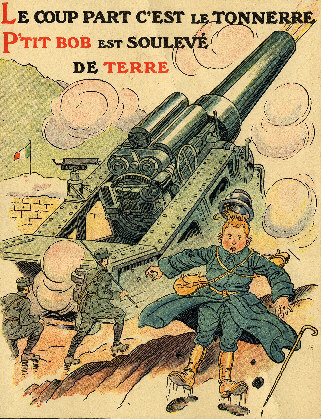
'The shell is fired, sounds like thunder
Little Bob is shook asunder'
From P'tit Bob, By Illustrator H. Lanos
GREAT WAR 2008 EVENT CALENDAR
|
|
|
WFA-USA National Seminar
Carlisle Barracks, PA
America's Great War -
America's Great Warriors
September 12-14 2008 (information)
|
Western Front Association
U.S. Branch Chapter Meetings
Check for Your Region
Regularly Updated (details)
|
Great War Society Monthly Chapter Meetings
Berkeley, San Francisco and Palo Alto, CA
Regularly Updated (details)
|
Send additions/corrections:
Email Response
|

Memorable Event
|
Haig's
"Backs to the Wall" Order
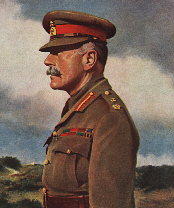
Douglas Haig's
Finest Hour
April 11, 1918
Click on Image To Learn More
|
|
Trip-Wire contributor Donna Cunningham has published her first novel. Its heroine is Leda Swann, a longtime systems engineer whose career has settled into a predictable routine. Things change when, hoping for adventure, she accepts a new job in Honolulu. There she discovers many new cultures, the local hospitality and its exotic food. There is another side to life in the beautiful islands, however. She must confront the dark and sinister side of government contracting. With the pressure and temptations surrounding her, will Leda be able to stay out of trouble? To find out whether she prevails over her perils in paradise, order a copy of D.B. (Donna) Cunningham’s The Aloha Diary, at your local bookstore or log on at Xlibris.com Incidentally, Donna, similarly to Leda, once worked in Hawaii as a systems engineer.
Our Ypres Salient Correspondent, Charlotte Descamps, Proprietor of the Varlet Farm B&B (link), has sent us news from Wipers. The outstanding Passchendaele Museum at Zonnebeke has two "happenings" of interest to our readers. From April 25 - November 15 there will be a special exhibit on "Brave Little Belgium," but it will have a special twist. Its focus will be on the important role Belgium played in the Allied Victory Offensive of 1918. Also, on Saturday 26 and Sunday 27 of April, more than 150 World War One re-enactors from eight different countries will set up a camp in the grounds of the Zonnebeke Chateau. Visitors will be able to walk among first aid posts, field kitchens, artillery and cavalry displays.
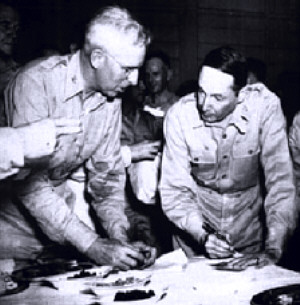
Who Are These WWI Veterans During WWII?
Readers will certainly recognize Rainbow Division veteran Douglas MacArthur. The officer on his right is BG Elliott R. Thorpe, who was his chief of counterintelligence during WWII and the occupation of Japan. An intelligence officer in the First World War, he has two remarkable historical distinctions. As pre-WWII military attache to Dutch Java, he gave one of the legitimate (and ignored) warnings of an impending attack on Pearl Harbor. Thorpe is also thought to be the only person present at both the signing of the Versailles Treaty on June 28, 1919 and the Japanese surrender on the decks of the USS Missouri, September 2, 1945.
 My subject is war, and the pity of war.
My subject is war, and the pity of war.
The poetry is in the pity.
Wilfred Owen, Preface
|
Mash Valley at Pozieres, Somme Battlefield
By Steve Miller
|
|
|
|
Page Two
|
|
|
THE last surviving veteran of the First World War living in France, an Italian immigrant who fought in the trenches with the Foreign Legion, has died at the age of 110. Lazare Ponticelli, who joined his adopted country's army as a 16-year-old at the outbreak of the war with Germany in 1914, had attended a memorial ceremony as recently as November 2007. (Story and photo) (Story on National Ceremony)
Click Here to See the Worldwide List of Surviving WWI Veterans
|

|
Fort Souville, Verdun Battlefield
By Christina Holstein
|
One of the lesser known sites at Verdun is Fort Souville, which stands in the heart of the battlefield and less than one kilometer from the Fleury Memorial Museum. One of the first forts to be built at Verdun after the defeat of France in the Franco-Prussian war of 1870, Fort Souville was originally built of stone and protected by the traditional ditch and drawbridge, although later modernization added a number of strong underground shelters and a retractable gun turret for two 155 mm guns. The fort stands on a high ridge, and in 1916 the views--now unfortunately blocked by forest--stretched for miles in all directions. This made Souville a vital part of the Verdun defensive system, and it became even more important once Forts Douaumont and Vaux had fallen into German hands. Throughout the battle, Souville offered command and medical facilities, shelter and rest to troops going into the French front line. Afterwards, it was estimated that between April and June 1916 the fort had been hit by 38,000 shells of all calibres, and although the parts above ground were largely destroyed, the underground shelters remained habitable throughout.
 |
A. Wartime Entrance to Barracks and Fort |
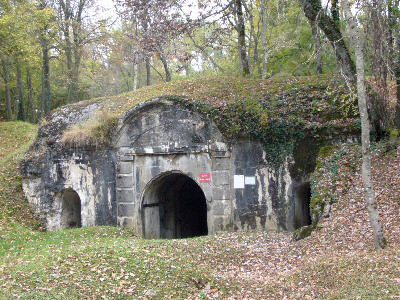 |
B. 155 mm Turret |
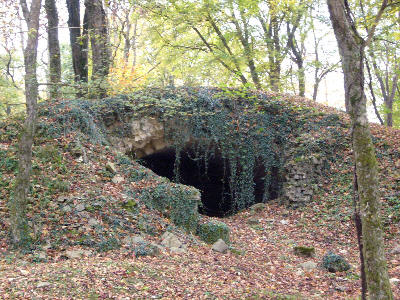 |
C. Battery Shelter |
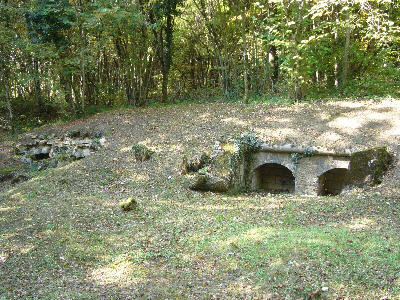 |
D. Ammunition Niches |
|
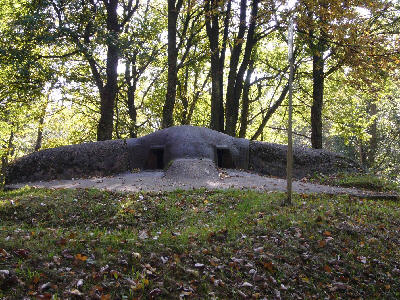 |
E. Pamard Turret |
The ridge to the south of the fort was the site of a number of important batteries and observation posts, as well as a unique 155 mm gun turret. These have recently been cleared, and information about the various positions has been provided in three languages. A visit to this ridge is well worth while but visitors should stay out of the remaining parts of Fort Souville, which are all very dangerous. To reach the ridge, follow the path sign posted Massif fortifié de Souville, which leaves the D112 between the wounded lion monument and the Maginot memorial.
|


Detail: River Clyde at V Beach, Cape Hellas, Gallipoli Peninsula, April 25, 1915
By Charles Dixon, R.A., Unveiled 1922; (Account of the Landing)
Click Here to Visit War in a Different Light
|
| Nelson County, Kentucky, Over Here and Over There on Armistice Day
|
Fifty years later, the local citizens and veterans recalled November 11, 1918. This report was recently republished by the county genealogical society.
At Home
People ran out of their houses shooting guns, crying, singing, hollering up to the skies. Some tied pieces of tin on the back of their cars and drove around the courthouse making more noise than on the Fourth of July, and other just sighed in relief. Most of the home folks didn't know the war was over until the early morning hours and rural people didn't hear about it until well up in the day, but when they did they went wild with joy and celebrated just like their city brothers.
Lindsay Price, 32nd Division, AEF
World War I veteran Lindsey Price, of 218 East John Fitch, Bardstown, has a vivid memory of the day. He was a machine gunner with American forces on the front lines, a member of the 28th Machine Gun battalion. He said he heard nothing about the war coming to an end until just before the cease-fire order. At exactly 11 a.m., the firing stopped, he said. "Germans came up from everywhere," he recalls, "out of holes just out of the earth with their hands up, all jabbering and expressing glee: and many speaking in English. We just stopped shooting and started laughing and hugging each other," he recalls. The average life on the front lines as a machine gunner was three minutes, he said. But Lindsay Price was on the front lines six months, was wounded twice, one time blown into a river and rescued by his buddies.
Tom Spalding, U.S. Navy
Bardstown businessman Tom Spalding was a young fellow serving in the Navy, but happened to be home due to the illness and death of his sister, Mrs. Julian Hurst. He remembered that it was night when the word came that the war was over, and people ran outside with guns, fired them into the air, and made every kind of noise they could think of. With no radio or TV, the good news spread by word of mouth, everyone a kind of Paul Revere in his own way.
Frank Wilson, 81st Division, AEF
Bardstown automobile dealer Frank Wilson recalls being in the Argonne Forest in France, a member of the 81st Division, known as the "Wildcat Division". He said they knew several hours ahead of time that the war was coming to an end, but official word came through at 11 o'clock in the morning to cease fire. Another Bardstown businessman, John C. Newcomb, who lives on a farm at New Hope, also was with American forces in the Argonne Forest. Lt. Wilson says he remained in France until July of 1919. He recalls that many men thought the war ended too quickly, as they did in World War II--they felt American forces should have come into Germany.
Leelan Hubbard, Fort Gordon, Georgia
The signing of the Armistice was a mix-up for Bardstown businessman Leelan P. Hubbard who was in officer training school at Fort Gordon, Georgia. He remembers that they were informed November 8th that the war was over and they staged a big parade in Atlanta, only to learn on returning to their Post that the information was false. However, on November 11th, when they received the official notice, they celebrated in true Army style at the Fort, overjoyed at the thought of returning home.
Arch Pendergrass, 77th Division, AEF
Arch Pendergrass, Sr., Deatsville, who was serving with the 77th Infantry Division in France, posted in the front lines, recalls the day "exactly." "We fought right up to exactly 11 o'clock in the morning when the firing suddenly stopped I just stood in a daze, the silence was so unfamiliar." He said he "took a deep breath, just couldn't believe it was over."
From frequent Trip-Wire contributor MG Tom Jones, USA, ret., whose family has roots in Nelson County.
|
|

|
1918 on The Western Front
By Tony Noyes
April
Operation Georgette
|
[Tony is a little indisposed this month, so we have drawn on other sources for this month's entry.]
Operation Michael, Ludendorff's March Offensive in the Somme sector, had drawn British forces to defend Amiens, leaving the rail route through Hazebrouck and the approaches to the Channel ports of Calais, Boulogne and Dunkirk vulnerable. German success here could choke the British into defeat.
The next attack, code-named Operation Georgette, started on April 9th after a firewaltz. The Portuguese defenders at the point of attack were rapidly overrun, but the British resistance on either flank held and threatened the German breakthrough. Despite this and other Allied actions, the Germans made rapid progress and, without French reinforcement, it was feared that the remaining 15 miles to the ports could be covered within a week.
However, the German offensive had stalled because of logistical problems and exposed flanks. Counterattacks by British, French, Canadian and ANZAC forces had slowed and stopped the German advance. Ludendorff ended Georgette on April 30th.
|

As with Michael, losses were roughly equal, with approximately 110,000 men wounded or killed on each side. Again, the results were disappointing for the Germans. Hazebrouck remained in Allied hands, and the flanks of the German salient were vulnerable.From the German History Notes website.
|
|
If you are travelling to Europe and would like to visit these fields of memory for a detailed tour, please contact experienced guides Tony Noyes or Christina Holstein at Verdun Tours
|
|
|
Subscribe to Our New On-Line Magazine
|

|
|
|
Page Three
|
 |
A Major World War One Publishing Event
The Joseph M. Bruccoli Series
|
Professor Matthew Bruccoli at the University of South Carolina is a leading authority on F. Scott Fitzgerald, but he has another mission he pursues. His father Joseph's service in the Great War shaped his own life as much as it did his dad's. Joseph, an American soldier, found himself driving a Pierce-Arrow truck in a unit attached to the French Army. He managed to find the front lines in eight major campaigns and returned from the war both wounded and shell-shocked. He retained, however, his love of country and his appreciation for his fellow soldiers who served alongside him, Over There. He passed on these values to his son, who shares them with his students and colleagues today, in an often hostile academia.
Inspired by his father's service and patriotism, Professor Bruccoli has spent a lifetime gathering artifacts, books, music, posters and memorabilia from the war for researchers and to keep the spirit of the Doughboys alive for posterity. The collection is so vast that it is housed at two major libraries, the state universities of South Carolina and Virginia. Studying the literature of the war is a secondary academic specialty of Professor Bruccoli. He has become a leader in rediscovering some of the classics of the war--novels, memoirs and personal statements that are often forgotten today. Earlier in his career he participated in the release of Thomas Boyd's U.S. Marine Classic Through the Wheat with Southern Illinois University Press.
He has now combed the archives of the Bruccoli collection and has persuaded his university press in South Carolina to release ten of these forgotten literary gems in a series. Naturally, he has dedicated it to his father, Joseph Bruccoli. The first five releases are now available and are displayed on the right. They are printed in quality paperback format and are beautifully designed as a set. The second group of five titles are planned for release in late 2008 or early 2009. The second batch will include the story of the British retreat in March 1918, an account of Australian service on the Western Front, and an all-verse account of battlefield experience in the American Army edited by Trip-Wire reader Bradley Omanson titled This Man's Army: A War
in Fifty-Odd Sonnets.
Order from the University of South Carolina Press (link). (Unfortunately, you have to track down the titles separately, they are not grouped together as a set as on the flyer pictured here.)
|
World War I Headlines
in the
21st Century
|
|
Gelibolu
By Andrew Melomet
The story of disastrous Battle of Gallipoli is told in the 2005 documentary Gallipoli (Gelibolu in Turkish). Produced, written and directed by Tolga Örnek, this is the best film I have ever seen on Churchill's disastrous Dardanelles campaign. And that includes the excellent 1981 feature film, Gallipoli, directed by Peter Weir and the well-done documentaries from Cromwell Productions.
Gelibolu, the most successful documentary in Turkish history, was six years in the making from preproduction planning to production and editing. Eighteen months of research were done before work started on the script. The location shooting lasted about forty days. Footage was shot on the Gallipoli peninsula in April to capture the color and light that was present at the start of the campaign. Dugouts and trenches were built on the Aegean Coast on the Dardanelles at a military facility for the reenactments and extensive explosive sequences. After a trip to Australia and New Zealand for interviews and archival film material, the filmmakers returned to Turkey in the fall for additional location shooting.
The moving narration is shared by Jeremy Irons and Sam Neill. The wide-screen production values are very high and use photo animation techniques of still photos, archival film footage and carefully done reenactments to tell a compassionate story of more than 120,000 deaths by machine gun and rifle fire, artillery, mines and dysentery. Men swelter in the heat, drown in flooded trenches and freeze to death in winter.
Extensive research in every country that held collections on Gallipoli allowed Örnek to base his narrative structure around the letters and diaries of eight Allied and two Turkish soldiers and uses quotes from twenty-seven different soldiers and officers. Only 5 percent of the Turkish troops were literate, limiting the correspondence and diaries the filmmakers could use. The individuals selected represent all the troops, their different backgrounds and their reasons for being there. Each of the ten main protagonists is developed as an individual character and personality, something that is not always easy to do in a documentary. Over the course of the campaign, these men endure suffering and death. The film covers the changes in their personalities.
Gelibolu focuses on the shared suffering and sacrifice endured by both sides. There is no glory of nationalism depicted, only the horror and degradation of war. In response to Turkish criticism Örnek has stated in a 2005 interview with the World Socialist Web Site that his film, 'Doesn't have a nationalistic agenda, it is not a propaganda tool, nor is it concerned with promoting Turkey. My film is about ordinary soldiers and makes clear that the real enemy is not people but war itself."
British officials and highly placed strategists approved the campaign without heeding warnings against an assault by land or sea. The stated goal was to capture the Dardanelles and allow Allied ships to supply Russia. But the Allies had no post-invasion plan. They seemed to expect that the Turks would simply surrender and go along with whatever the Allies wanted.
The similarity between Gallipoli and our current efforts in Iraq is obvious but, according to Örnek, unintentional. In the 2005 interview with the World Socialist Web Site he stated, "I didn't plan to make these parallels in the film, but it is so obvious. One thing history seems to teach us is that we don't ever seem to learn from history. The British generals had no real idea about what they would face from the Turkish military. They didn't know what would happen after their troops came onshore or where they would go. It is the same situation in Iraq. The U.S. government simply declared to the rest of the world that they would capture Baghdad depose Saddam and then somehow the Iraqis would agree and accept this. The parallels with Gallipoli are uncanny."
[The views expressed above are not those of the Publisher/Editor]
How did the Australians feel about a Turkish filmmaker telling the story of Gallipoli, regarded as a defining terrible moment in Australian history? Örnek was awarded an honorary medal in the general division of the Order of Australia for producing Gelibolu.

ANZAC Beach Depiction from Gelibolu
Gelibolu has been released on DVD as Gallipoli from Epoch Media. It is available on-line from Amazon and Netflix. I highly recommend it.
Andrew Melomet, Proprietor of Andy's Nickelodeon, will answer your Great War film or video inquiry. He is also soliciting your recommendations for the WWI Filmography he is compiling for our readers. Just click HERE.
|
|
| The following are thanked for their contributions to this issue of the Trip-Wire: Len Shurtleff, Tom Jones, Leo Benedetti, Steve Miller, Tony Langley (L'il Bob's translator), Christina Holstein, Tony Noyes, Andrew Melomet, Kimball Worcester and Matthew Bruccoli. Until next month, your editor, Mike Hanlon. |
SUBSCRIBE TO THE TRIP-WIRE
(Or send it to a friend)
(Or send us a comment on the TRIP-WIRE)
CLICK HERE TO CONTACT US VIA EMAIL |
For further information on the events of 1914-1918
and membership information visit the Directory Pages of:
|
| | |























